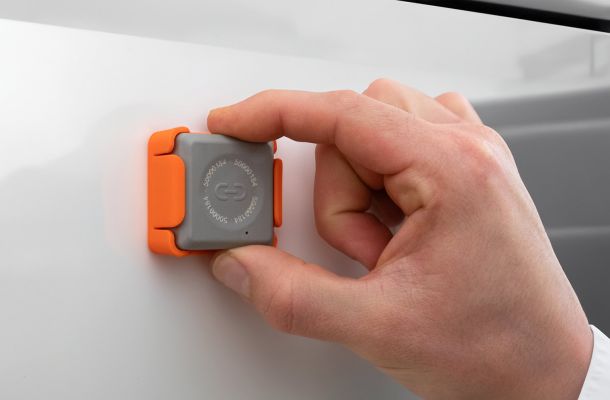Food cold chain: key role for freshness and quality
The cold chain of food is of crucial importance to ensure the freshness, quality and safety of products. The correct handling and maintenance of the cold chain plays a key role for the entire food industry. In this article, you will learn what a cold chain is, what challenges exist and how compliance with the cold chain can be documented.
What is a cold chain?
The process that describes the uninterrupted cooling of food or goods requiring refrigeration on the way from production to the end consumer is known as the cold chain. The cold chain extends from production, storage and transport through to storage and display in retail outlets. To ensure that the cold chain is maintained, technologies for permanent temperature control, refrigerated vehicles and insulated containers are used.
Regulations on the cold chain
Die Einhaltung strenger Vorschriften zur Lebensmittel Kühlkette ist von entscheidender Bedeutung, um die Sicherheit und Qualität von Lebensmitteln zu gewährleisten. Ein integraler Bestandteil dieser Vorschriften ist das HACCP-Konzept, das für “Hazard Analysis and Critical Control Points” steht. Alle Lebensmittelunternehmen, die an der Kühlkette beteiligt sind, müssen diesem systematischen Ansatz folgen, der die Identifizierung und Bewertung potenzieller Gefahren auf allen Stufen der Lebensmittelproduktion, -lagerung und -verteilung vorschreibt. Kritische Kontrollpunkte (CCPs) werden dann definiert, um sicherzustellen, dass Gefahren auf ein akzeptables Maß reduziert werden. Das HACCP-Konzept dient nicht nur der Optimierung von Abläufen, sondern auch zur Eigenkontrolle.
With regard to compliance with temperatures, the Regulation (EC) No 852/2004 stipulates that food business operators must ensure that appropriate measures are taken throughout the food supply chain to ensure that food, particularly perishable food, is stored and transported at temperatures that guarantee its safety and quality. This includes closely monitoring temperatures to ensure compliance with established standards and to minimise the risk of harmful micro-organisms multiplying.
The TLMV stipulates that the basic cold chain temperature of -18 °C may be subject to upward deviations, including short-term fluctuations of no more than 3 °C during dispatch and deviations of no more than 3 °C during local distribution and in retail freezers as part of bona fide storage and distribution procedures. Strict application makes it possible to proactively manage risks, improve food safety and effectively control the entire cold chain process.
Why must the cold chain not be interrupted?
Interrupting the food cold chain can have serious consequences:
Maintaining an uninterrupted cold chain is crucial for the quality, safety and shelf life of perishable food. Any interruption in the cold chain carries the risk of temperature fluctuations, which in turn can favour the growth of microorganisms. This can lead to loss of freshness and even health risks for the consumer. The cold chain must be unbroken from production to transport to storage at retail and finally to the consumer's home in order to avoid premature spoilage, microbial growth or loss of quality.
Challenges in the cold chain
a. Energy consumption: Maintaining the cold chain requires considerable amounts of energy. This high energy consumption raises environmental concerns as it contributes to increased CO2 emissions. The food industry is therefore looking for sustainable solutions to minimise energy consumption while meeting refrigeration requirements.
b. Transport risks: Interruptions during transport pose a significant risk to the cold chain. Power failures, technical defects or unplanned stops can affect temperature control and therefore jeopardise the quality of the food. Companies rely on advanced technologies and monitoring systems to minimise such risks and ensure an uninterrupted cold chain.
c. Temperature documentation: Companies often use disposable data loggers to document the transport temperature. This unsustainable solution generates waste and can be a financial burden. In addition, the manual evaluation of offline data loggers is time-consuming and prone to errors. The lack of real-time monitoring makes it difficult to recognise temperature deviations in good time. In addition, temperature documentation requirements are becoming increasingly stringent, further increasing the need for innovative solutions to ensure quality and safety in the cold chain.
Technology for automatic monitoring of the cold chain
In view of increasing requirements for temperature documentation, companies are increasingly relying on advanced technologies to automatically monitor the cold chain. Intelligent sensors, IoT (Internet of Things) and wireless transmission systems enable a fully automatic and permanent Documentation of the temperature conditions during the entire logistics process. The integration of automated monitoring systems therefore not only improves efficiency, but also the sustainability of the cold chain, as the use of disposable data loggers is reduced.
Conclusion
The cold chain is crucial for the safety and quality of food. By investing in IoT sensors for automatic temperature documentation, companies ensure continuous monitoring of the cold chain. This not only ensures compliance with regulations, but also maintains the freshness and quality of the food - a crucial contribution to consumer safety and satisfaction.


